Prevention of Falls Among 65+
Facts About Falls
Each year one in every three adults 65 and older will fall (Hausdorff,Rios,&,Edelber, 2001). In 2009 2.2 million nonfatal fall injuries were treated in emergency rooms (CDC,2010). In 2007 more than 18,000 older adults died from non intentional fall injuries. Among those 65 and older, falls are the leading cause of injury death. They are also the most common cause of nonfatal injuries and hospital admissions for trauma (CDC,2010). In 2000, the direct medical costs attributed to falls was a little over $19 billion (Stevens, Corso, Finkelstein, & Miller, 2006)
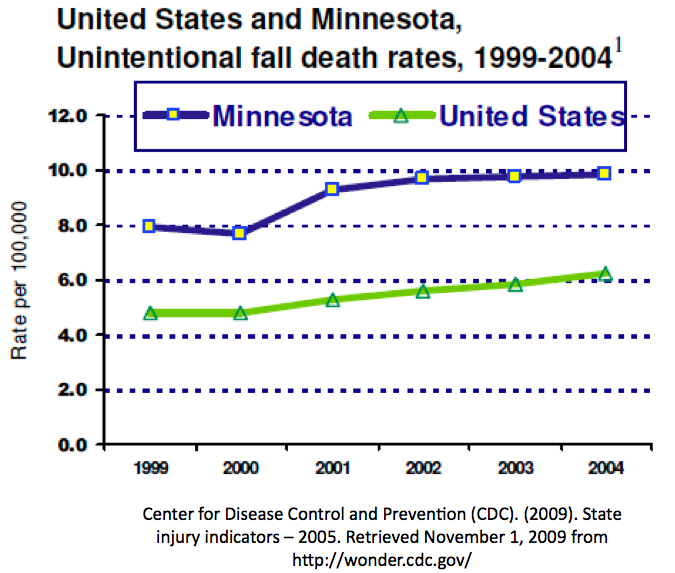
- Men are more likely to fall compared to women
- Women are more likely to be injured in a fall
- Each year one in every three adults 65 and older will fall
- Falls are the most common cause of traumatic brain injury
- People who fall may develop a fear of falling, which may decrease their physical activity in turn leading to more falls
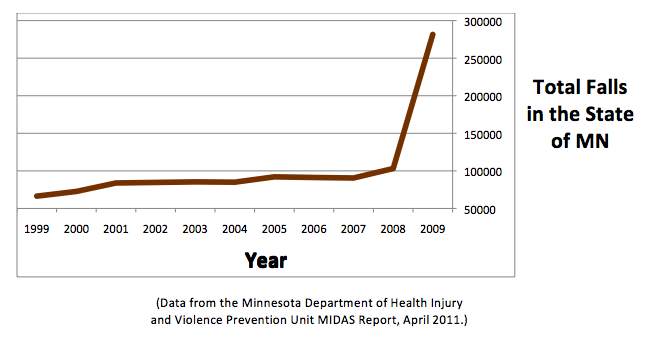
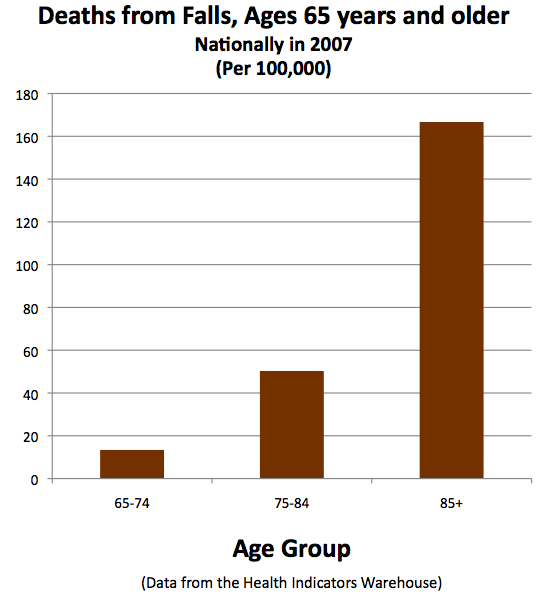
Goals & Objectives
Goal
Create a cohesive community based awareness that will decrease the number of falls among those 65 and older
Objectives
- Create awareness of the prevalence and risk factors related to elderly falls
- Make assessment tools available to elderly and those who interact with the elderly
- Enable individuals to take action within their own homes
- Enhance quality of life through fall prevention
- Decrease reliance on medical and first responder resources by preventing falls among the elderly
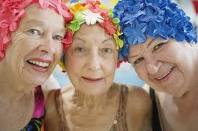
Community Partners
Adults 65+ Living at Home
What older adults can do in their homes to prevent falls?
- Have a doctor review medications
- Exercise regularly (weight barring activities)
- Have regular eye check ups
- Make sure to get enough calcium and vitamin D
- Remove tripping hazards (throw rugs, shoes, books, and papers)
- Make sure there is good lighting
- Add grab bars and railings in your home
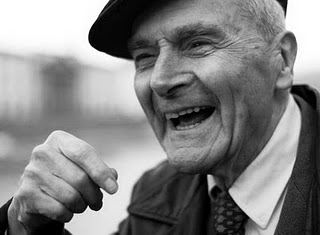
Community Partners
Professional Health Care Facilities & Health Care Professionals
What professional care facilities can do to prevent falls:
- Make sure staff is trained properly and committed to reducing falls
- Educate staff on procedures that should take place after a fall
- Ensure that all areas of the care facility are safe
- Make sure reports are filed so data can be recorded
- Make sure residents have adequate supervision at all times
- Have an ample amount of safety devices in place for residents
- Transfer residents properly at all times
- Never leave a resident unattended in places such as the bathroom
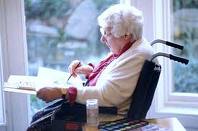
Community Partners
Caregivers & Families
- Complete a risk assessment test of the home. This will be a good starting point so you know what things need to be changed or modified immediately. An assessment tool is available in the Assessment Tools.
- Help ensure that those 65 and older are able to be active, and encourage them to be active by arranging transportation
- Make sure their home is kept free of debris and spills
- Help install guard rails and grips in the tub if appropriate
- Help install the best possible lighting
- Encourage those 65 and older to use night lights in the bedroom and bathroom along with any other place that may need additional lighting at night
- Have convenient resources like a cordless phone readily available
- Check in often with your family members 65 and older to make sure that they are feeling and doing well
- Remove area rugs, which can increase the chances of falling
- Make sure those 65 and older are getting regular checkups. This will ensure that there are no side effects to medicine
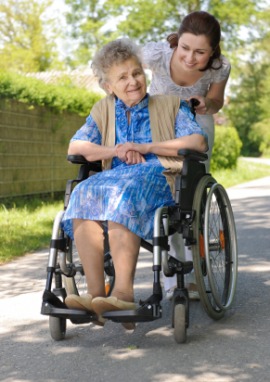
Assessment Tools
FRAX – a tool developed by the WHO to evaluate fracture risk of patients
www.shef.ac.uk/FRAX/
Fall Prevention Checklist
www.mnsafetycouncil.org/seniorsafe/falls/index.cfm
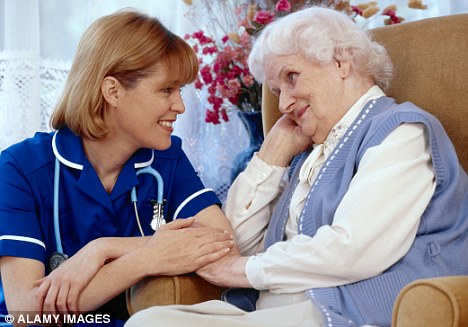
Resources
Falls Free Coalition: Advancing and Sustaining a State-Based Falls Prevention Agenda
www.healthyagingprograms.org/content.asp?sectionid=113&ElementID=854
Preventing Falls: How to Develop Community-Based Fall Prevention Programs for Older Adults
www.cdc.gov/HomeandRecreationalSafety/Falls/preventfalls.html#DevCommunityPrg
Falls Among Older Adults: Brochures and Posters
www.cdc.gov/HomeandRecreationalSafety/Falls/fallsmaterial.html
Legislation: Safety of Seniors Act
www.glin.gov/view.action?glinID=205829
Information for Individuals and Families
www.stopfalls.org/individuals_families/index.shtml
Minnesota Organizations & Coalitions
MN Falls Prevention Initiative
http://www.mnfallsprevention.org/index.html
1-800-333-2433
American Physical Therapy Association (APTA) - MN Chapter
http://www.mnapta.org/
651-635-0902
MN Board on Aging
http://www.mnaging.org/
1-800-882-6262
P.O. Box 64976
St. Paul, MN 55164-0976
Elder Network
http://www.elder-network.org/
1-507-285-5272
MN Safety Council
http://www.minnesotasafetycouncil.org/family/falls.cfm?qs=383B469B84EE5D0C423401A73F0D529A
1-800-444-9150
Caregiver & Elder Advocacy Organizations
Elder Care Rights Alliance
Information on how to advocate for resident care; also great for information on elder neglect.
Bloomington, Minnesota
http://www.eldercarerights.org/Home_flash.htm
The National Citizens' Coalition for Nursing Home Reform
A national resource for seniors regarding abuse and neglect issues.
http://www.theconsumervoice.org/
1001 Connecticut Avenue, NW, Suite 425
Washington, DC 20036
tel: 202.332.2275
fax: 202.332.2949
info@theconsumervoice.org (e-mail)
The US Department of Health and Human Services (National Center on Elder Abuse)
Contains information about elder abuse, abuse reporting and neglect. Also great for state specific information.
http://ncea.aoa.gov/ncearoot/Main_Site/index.aspx
National Center on Elder Abuse
c/o Center for Community Research and Services
University of Delaware
297 Graham Hall
Newark, DE 19716
Minnesota Board on Aging (Senior Link Age Line)
Great way to find local information.
http://www.mnaging.org/advisor/SLL.htm
tel: 1.800.333.2433
Alzheimer's Association Minnesota- North Dakota Chapter
Offers education for those who interact with patients diagnosed with Alzheimer's and dementia.
http://www.alz.org/mnnd/
24/7 Helpline
Contact us for information, referral and support.
tel: 1.800.272.3900
tdd: 1.866.403.3073
e-mail: info@alz.org
National office
225 N. Michigan Ave., Fl. 17
Chicago, IL 60601-7633
tel: 312.335.8700
tdd: 312.335.5886
fax: 1.866.699.1246
References
1) Centers for Disease Control and Prevention, National Center for Injury Prevention and Control. Web -based Injury IStatistics Query and Reporting System (WISQARS) [online]. Accessed November 30, 2010.
2) Hausdorff JM, Riods DA, Edelber HK. Gait variability and fall risk in community-living older adults: a 1-year prospective study. Archives of PHysical Medicine and Rehabiilitation 2001;82(8):1050-6.
3) Stevens JA, Corso PS, Finkelstein EA, Miller TR. The costs of fatal and nonfatal falls among older adults. Injury Prevention 2006b;12:290-5.








